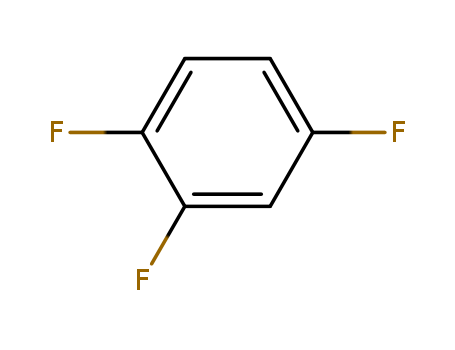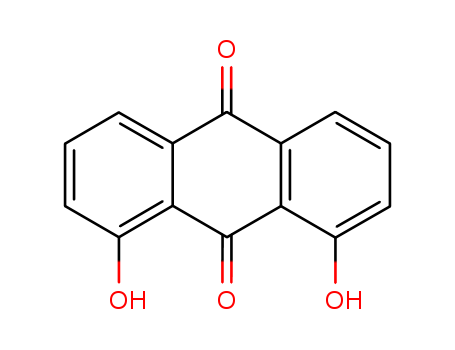
117-10-2
- Product Name:1,8-Dihydroxyanthraquinone
- Molecular Formula:C14H8O4
- Purity:99%
- Molecular Weight:240.215
Product Details;
CasNo: 117-10-2
Molecular Formula: C14H8O4
Appearance: orange-brown or brown powder
Wholesale Buy Reliable Quality 1,8-Dihydroxyanthraquinone 117-10-2 Customized Supply
- Molecular Formula:C14H8O4
- Molecular Weight:240.215
- Appearance/Colour:orange-brown or brown powder
- Vapor Pressure:8.21E-09mmHg at 25°C
- Melting Point:191-193 °C
- Refractive Index:1.732
- Boiling Point:452.667 °C at 760 mmHg
- PKA:6.27±0.20(Predicted)
- Flash Point:241.691 °C
- PSA:74.60000
- Density:1.541 g/cm3
- LogP:1.87320
1,8-Dihydroxyanthraquinone(Cas 117-10-2) Usage
|
Description |
1,8-Dihydroxyanthraquinone, a natural product, was originally extracted from the roots and rhizome of Polygonaceae plant, also called Da Huang in traditional Chinese herbal medicine. Danthron is reasonably anticipated to be a human carcinogen. Danthron is an anthraquinone that exists at room temperature as a red or orange crystalline powder.It is practically insoluble in water, but soluble in a variety of solvents (acetone, chloroform, diethyl ether, ethanol) and alkaline hydroxide solutions. The stability of danthron is generally good. It is stable under room temperatures and normal pressures. |
|
Chemical Properties |
orange-brown or brown powder, Orange crystalline powder. Almost odorless and tasteless. |
|
Uses |
Important intermediate in the manufacture of alizarin and indanthrene dyestuffs; forms insoluble Ca, Ba, Pb lakes. Antioxidant in synthetic lubricants; fungicide. |
|
Definition |
ChEBI: A dihydroxyanthraquinone that is anthracene-9,10-dione substituted by hydroxy groups at positions 1 and 8. |
|
Brand name |
Dorbane (3M Pharmaceuticals); Istizin (Sterling Winthrop);Doss;Normax;Regulex-d. |
|
World Health Organization (WHO) |
1,8-Dihydroxyanthraquinone, an anthroquinone derivative, has been available for over twenty years and is widely used as a laxative. The results of two chronic toxicity studies in rodents, published in 1985 and 1986, have shown that administration of high doses is associated with the development of intestinal and liver tumours. |
|
Air & Water Reactions |
Insoluble in water. |
|
Reactivity Profile |
1,8-Dihydroxyanthraquinone is incompatible with strong reducing substances such as hydrides, nitrides, alkali metals, and sulfides. |
|
Fire Hazard |
Flash point data for 1,8-Dihydroxyanthraquinone are not available; however, 1,8-Dihydroxyanthraquinone is probably combustible. |
|
Safety Profile |
Confirmed carcinogen with experimental carcinogenic data. Moderately toxic by intraperitoneal route. An eye irritant. Questionable carcinogen with experimental carcinogenic and neoplastigenic data. Human mutation data reported. A laxative. When heated to decomposition it emits acrid smoke and irritating fumes. |
|
Potential Exposure |
A potential liver carcinogen and possible narcotic, this compound is no longer sold or marketed in the United States Nervous system toxin-acute effects; Respiratory toxin-acute effects other than severe or moderate irritation; Liver-acute effects; Eye irritant-mild. |
|
Carcinogenicity |
1,8-Dihydroxyanthraquinone is reasonably anticipated to be a human carcinogen based on sufficient evidence of carcinogenicity from studies in experimental animals. |
|
Environmental Fate |
1,8-Dihydroxyanthraquinone can cause DNA damage particularly at guanines in the 5'-GG-3', 5'-GGGG-3', 5'-GGGGG-3' sequences in the presence of Cu(II), cytochrome P450 reductase and the nicotinamide adenine dinucleotide phosphate (NADPH)-generating system. H2O2 and Cu(I) may also be involved because this DNA damage can be inhibited by catalase and bathocuproine. The further mechanism is danthron is reduced by P450 reductase and generate reactive oxygen species through the redox cycle, leading to extensive Cu(II)-mediated DNA damage. The DNA damage also comes from similar topoisomerase II inhibitor behavior of danthron. |
|
Shipping |
UN2811 Toxic solids, organic, n.o.s., Hazard Class: 6.1; Labels: 6.1-Poisonous materials, Technical Name Required. |
|
Purification Methods |
Crystallise Danthrone from EtOH and sublime it in a vacuum. [Beilstein 8 IV 3217.] |
|
Toxicity evaluation |
1,8-Dihydroxyanthraquinone is discovered in several species of plants and insects. It has been isolated from dried leaves and stems of Xyris semifuscata harvested in Madagascar, and roots of Da Huang, a Chinese traditional herbal medicine. 1,8-Dihydroxyanthraquinone also appears to be biosynthesized by some insects. The presence of danthron in insects may be a way of protection from predators. 1,8-Dihydroxyanthraquinone can be manually synthesized by many countries. In the United States, danthron was available from 12 suppliers. If released to the atmosphere, danthron will exist in both the vapor phase and the particulate phase. Vapor phase danthron has an estimated half-life of 11 days. Particulate phase danthron can be physically removed from air by wet and dry deposition. It is expected to biodegrade with 68% degradation within 3 months. If released to water, danthron is expected to adsorb to the surface of solid particle and sediment. Biodegradation is also a major pathway processed in water. It was reported that 82% of the added danthron was degraded by fresh water within 3 days. If added to seawater, 91% of danthron was reported as degraded. Danthron may bioconcentrate in aquatic organisms, such as fish and shrimps. |
|
Incompatibilities |
Keep away from strong reducing agents, such as hydrides, nitrides, alkali metals, and sulfides. |
|
Waste Disposal |
It is inappropriate and possibly dangerous to the environment to dispose of expired or waste drugs and pharmaceuticals by flushing them down the toilet or discarding them to the trash. Household quantities of expired or waste pharmaceuticals may be mixed with wet cat litter or coffee grounds, double- bagged in plastic, discard in trash. Larger quantities shall carefully take into consideration applicable DEA, EPA, and FDA regulations. If possible return the pharmaceutical to the manufacturer for proper disposal being careful to prop- erly label and securely package the material. Alternatively, the waste pharmaceutical shall be labeled, securely packaged and transported by a state licensed medical waste contractor to dispose by burial in a licensed hazardous or toxic waste landfill or incinerator. |
InChI:InChI=1/C14H8O4/c15-9-5-1-3-7-11(9)14(18)12-8(13(7)17)4-2-6-10(12)16/h1-6,15-16H
117-10-2 Relevant articles
Inclusion complex formation of 1,8-dihydroxyanthraquinone with cyclodextrins in aqueous solution and in solid state
Giulietta Smulevich, Alessandro Feis, Giovanni Mazzi, Franco F. Vincieri
, Journal of Pharmaceutical Sciences, Volume77, Issue6 June 1988 Pages 523-526
The results showed that whereas the self-association process was found for 1,8-dihydroxyanthraquinone alone, the monomeric form is microincluded in β- and γ-cyclodextrins.
Oxidation of antipsoriatic 10-acyldithranolderivatives and dithranol to 1,8-dihydroxyanthraquinone
Taskinen,Haarala,Wartiovaara,Halmekoski
, p. 103 - 106 (1988)
-
REGIOSPECIFIC SYNTHESIS OF QUINIZARIN DERIVATIVES BY CYCLOADDITION
Cameron, Donald W.,Feutrill, Geoffrey I.,McKay, Peter G.
, p. 701 - 702 (1981)
Cycloaddition of (E)-1,1,4-trimethoxy-1,...
Electron Paramagnetic Resonance, ENDOR and TRIPLE Resonance of some 9,10-Anthraquinone Radicals in Solution. Part 3. - Hydroxyanthraquinones
Maekelae, Reijo,Vuolle, Mikko
, p. 2569 - 2573 (1990)
EPR, ENDOR and TRIPLE resonance spectra ...
A biocatalytic approach towards the preparation of natural deoxyanthraquinones and their impact on cellular viability
Das, Kiran,De, Arijit,Husain, Syed Masood,Maity, Biswanath,Mondal, Amit,Rajput, Anshul
, p. 3087 - 3090 (2022/02/21)
Herein, a two-step chemoenzymatic proces...
117-10-2 Process route
-

- 162750-61-0
1,8-dihydroxy-10-(1-oxo-4-phenylbutyl)-9(10H)-anthracenone

-

- 117-10-2
1,8-dihydroxy-9,10-anthracenedione

-

- 1821-12-1
4-Phenylbutyric acid
| Conditions | Yield |
|---|---|
|
With oxygen; In ethanol; at 25 ℃; for 240h; Mechanism; other solvent; determinations of half-lives;
|
-
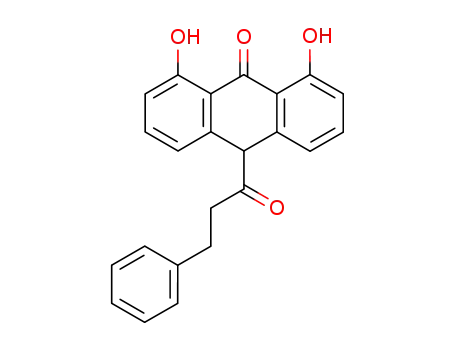
- 151562-48-0
1,8-Dihydroxy-10-(1-oxo-3-phenylpropyl)-9(10H)-anthracenone

-

- 117-10-2
1,8-dihydroxy-9,10-anthracenedione

-

- 501-52-0
3-Phenylpropionic acid
| Conditions | Yield |
|---|---|
|
With oxygen; In ethanol; at 25 ℃; for 240h; Mechanism; other solvent; determinations of half-lives;
|
117-10-2 Upstream products
-
5539-66-2
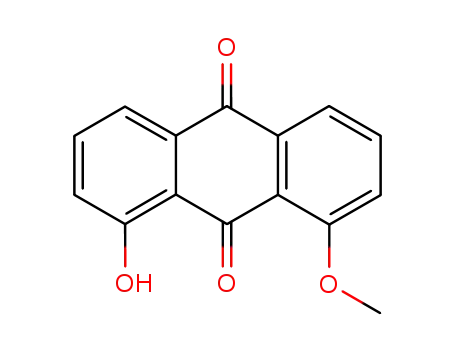
1-hydroxy-8-methoxyanthraquinone
-
1758-68-5
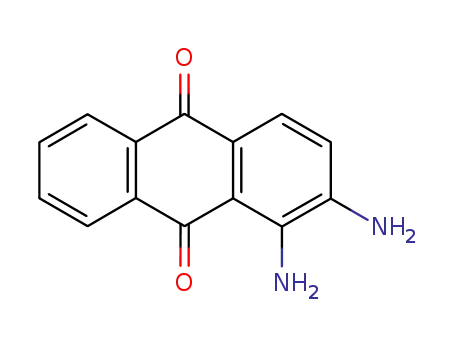
1,2-diamino-9,10-anthraquinone
-
82-48-4
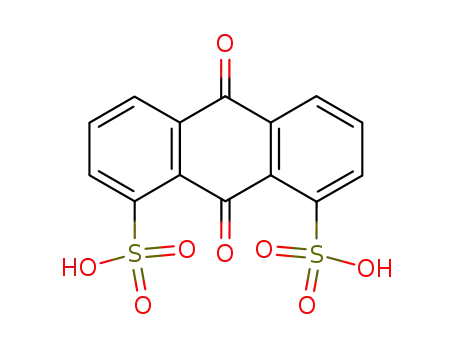
1,8-anthraquinonedisulphonic acid
-
478-43-3
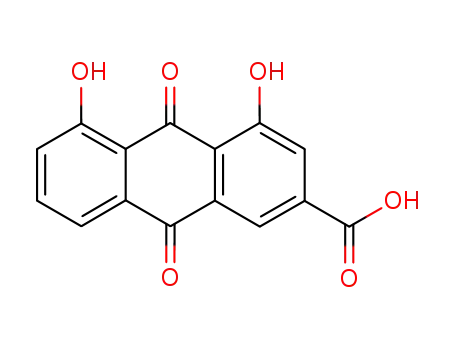
1,8-dihydroxy-3-carboxy-anthraquinone
117-10-2 Downstream products
-
16294-26-1
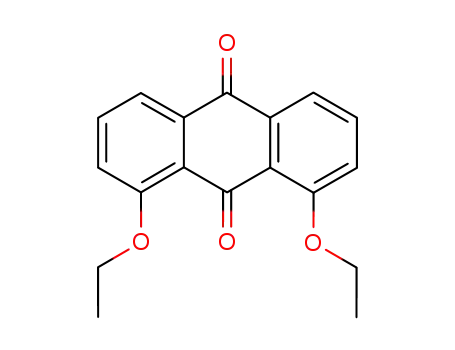
1,8-Diethoxyanthrachinon
-
480-22-8
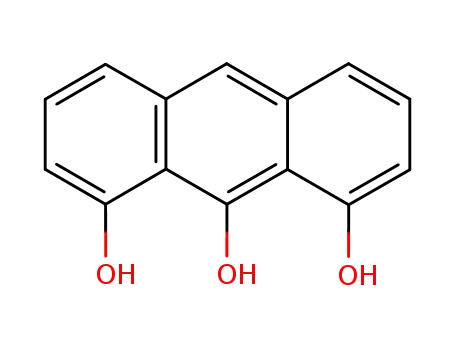
1,8,9 trihydroxyanthracene
-
1143-38-0

1,8-dihydroxy-9(10H)-anthracenone
-
81-55-0
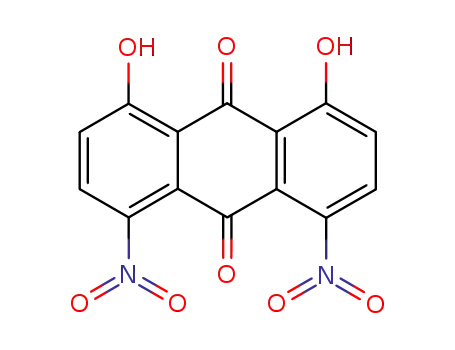
1,8-dihydroxy-4,5-dinitro-anthraquinone
Relevant Products
-
1,2,3-Trifluoro-4-nitrobenzene
CAS:771-69-7
-
1,2,4-Trifluorobenzene
CAS:367-23-7
-
2,2-Dimethyl-1,3-dioxane-4,6-dione(meldrum's acid)
CAS:2033-24-1







